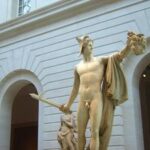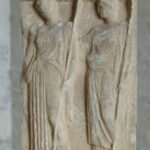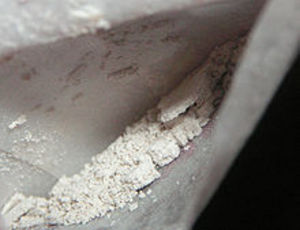To study Persephone is to study a goddess of great mystery and striking contrasts. She has a dual nature and is even known by two different names. She is Kore; goddess of spring and fertility, a beautiful maiden beloved by her mother, picking flowers in a field. She is Persephone; queen of the underworld, goddess of weddings and marriage, goddess of winter, beloved of Hades, deep and mysterious, sending specters to mortals and ruling over ghosts and spirits. She is a complex and intriguing deity, and understanding her can become quite frustrating. She is usually seen and worshipped in connection with either Demeter or Hades, and is rarely portrayed alone. She has no stable place at Olympus, unlike other children of Olympian gods.
Persephone is the daughter of Zeus and Demeter, the harvest goddess. “Demeter loved her daughter with all the warmth and devotion of a human mother.”[1] She is described as very beautiful, with slim ankles and either black or blonde hair. She was cheerful, compliant, and innocent, and is said to have played with Athena and Aphrodite. She loved to gather flowers. “This is truly a divine childhood, and though Persephone outwardly becomes a maiden, she remains until her abduction this dreamy self-enclosed child.”[2]The most famous myth surrounding her is the story of her abduction. Hades had seen the maiden Kore, and asked Zeus to arrange their marriage. Zeus did not want to anger either Hades or Demeter, so he did nothing. One day while Kore was in a field picking flowers, Hades arrived in a golden chariot drawn by two black horses and kidnapped her. When Demeter realized she was missing, she searched the whole world for her, and neglected her duties to the earth. Kore grieved for her mother, the sun, and flowers. When Zeus realized what had occurred he feared for the mortals. They would starve if Demeter did not allow anything to grow. He ordered Hades to return Persephone to her mother so the earth would no longer suffer. Hades knew that no one could return from the Underworld if they had eaten or drank anything while there, so he tricked Persephone into eating pomegranate seeds. Zeus decreed that Persephone would be queen of the Underworld for a third of the year, and live on earth with Demeter for the remainder of the time.
This story gives us the origins of the seasons. For the four months Persephone remained in the underworld, “all nature mourned with Demeter the loss of Persephone”.[3] This became winter, the time of year when nothing will grow. When Persephone returned to earth we had spring, and the earth is very fertile and blessed by Demeter. This also explains Persephone’s association with fertility. This aspect of Persephone is bound up with her mother. She is an integral figure in the mystery rites of Euleusis, where the two goddesses are worshipped together.
The Euleusinian mysteries are based on Persephone’s abduction and Demeter’s search for her. This cult symbolizes death and rebirth, and is said to have been started by Demeter herself. After being reunited with Persephone, she shared her secrets with mortals, beginning the mystery rites. “Persephone is the focus of the secret part of the cult…”[4] and these rites shown only to initiates remain unknown today. They seem to involve regeneration, and initiates were promised immortality in the underworld.
There were several women only festivals dedicated to the worship of Demeter and Persephone. The Stenia festival in Athens, held on the ninth day of Pyanopsion, was concerned with women and agrarian fertility. At Thesmorphia, held two days later, Kore is mentioned in the opening prayer, and Nesteia, a day of fasting, was associated with Demeter’s fasting after the disappearance of Persephone. The Athenian Haloa festival, 26 Posideion, concerned the mysteries of Demeter, Kore, and Dionysos. This celebration included much wine, representations of genitalia, suggestions of adultery, feasting, and promoted fertility. The Skira festival was held at Skiron on the twelfth of Skirophorion near a sanctuary of Kore and Demeter. Women chewed garlic “to keep sex at bay”.[5]
In association with the cult at Euleusis, Demeter and Kore received dedications of clothing, gold items, statues, houses, and monetary contributions to build sanctuaries. Such gifts by worshippers displayed piety, and men allowed their wives to make these donations in their own names.
It is often difficult to separate Persephone from her mother. Most stories center on her abduction and the grieving of Demeter for her lost daughter. They are usually worshipped in conjunction with each other, most commonly at Euleusis and then Athens. Persephone does have a separate identity, however, and although mysterious it is very important. “The goddess who rules in Hades represents the mystery of the unknown, its fearfulness and its unforgiveness.”[6]
Persephone is the consort of Hades, and as such, Queen of the Underworld and “the silent goddess of death”.[7] In some stories Persephone dislikes Hades and hates being married to him, in others she either likes him and doesn’t mind living in the Underworld, or she becomes infatuated with him and demands to spend all her time with him. They are seen as being faithful to each other for the most part, although there are a few exceptions. Hades is said to have flirted with two nymphs who Persephone quickly changed into plants. Minthe became mint, and Leuce became a poplar. Perhaps this apparent jealousy reveals Persephone’s true feelings for her husband. Persephone is also said to have had an attraction for the mortal Adonis, which caused problems with Aphrodite.
Aphrodite entrusted Persephone with the care of the mortal Adonis, wishing to hide him from her husband. Persephone became enchanted with him herself, and did not want to return him. Zeus once again arranged a compromise, granting one third of the year with Adonis to Persephone, one third to Aphrodite, and the remainder to Adonis to do with as he wished. He chose to spend his third of the year with Aphrodite, as he felt strongly for her as well.
“It is true also of Persephone that an important clue to her identity lies in the fact that she and Hades have no children: it is souls who are given life in the underworld, not children.”[8] Most stories claim that Persephone was barren, although some credit her with children. This seems ironic considering her connection with fertility of both women and the earth.
Persephone was said to be grim, cold, and unfeeling. She showed mercy rarely, such as in the case of Orpheus. “When Orpheus comes to beg for Eurydice’s release, he appeals to Hades and Persephone, ‘If there is any truth in the story of long ago, then you yourselves were brought together by love.'”[9] She agreed to allow Orpheus to take his wife Eurydice back to the land of the living. She was to walk behind him, and Orpheus was to never look back. He did, however, and so Eurydice had to remain in the Underworld.
In The Odyssey, Hades is next to the house of dreams. The Greek underworld is not terrible and horrifying, full of punishments and tortures, but simply: beyond life.”[10] The Groves of Persephone are located near the entrance to the Underworld, containing narcissus, poplars, aspen, mint, willows, white roses, poppies, aconite[11], pomegranate, and lilies. Black poplars stand at the entrance to the underworld.
“And while you are here, you shall rule all that lives and moves and shall have the greatest rights among the deathless gods: those who defraud you and do not appease your power with offerings, reverently performing rites and paying fit gifts, shall be punished for evermore.”[12] Persephone was also queen of the Erinyes, underworld demons who punished crimes of betrayal, impiety, and murder. She sent them whenever curses were spoken in her name. Despite the fact that she supposedly spent part of the year with Demeter, she always seemed present in the underworld, ready to greet visitors and to act as their host and guide. Indeed, Psyche found Persephone to be a generous and gracious host. She also loaned Cerberus to Heracles to help him complete his labors. She gave Odysseus a tour of the souls of women of great renown.
Persephone is described as being young, beautiful, and sad. Symbols representing her include the pomegranate, poppy, bat, and narcissus. It is frequently written that it was the narcissus that Persephone was picking when Hades came up from the underworld and stole her away.
While I have found no specific description of Persephone, her beauty must have been very great, indeed, to have inspired both her abduction by Hades and the unsuccessful kidnapping attempt of her by two mortals. Pirithous decided that he wanted Persephone for his bride, and so he convinced Theseus to help him kidnap her. Pirithous thought that even though she was married, she couldn’t love her husband, so it would be okay to marry her himself. Unfortunately for them, they sat in the Chair of Forgetfulness upon arrival and became permanent residents there. Some stories say that Heracles later rescued Theseus.
At the Nekromanteion Oracle of Ephyra, where the River Styx[13] flows into an underground chamber, offerings were once made to Hades and Persephone. This Oracle of the Dead is what the ancient Greeks believed to be the entrance to the underworld. People came here to commune with the dead, and were prepared for their meeting with the ghosts for several days before being led through the labyrinth to the meeting place. It is located near Parga, and is the most famous sanctuary of its kind. It remains open to the public today.
Persephone was the dreaded goddess of the shades, and some say second in power only to Hera. Many feared to speak her name. Her kingdom was the land of the dead, the underworld or Hades as it was often called. Here it was cold and the sun never shined. The palace of Hades and Persephone was known as the House of Hades. Their kingdom was divided into two main parts, Erebus and Tartarus.
Erebus was the upper part, divided by five rivers. These rivers were Acheron (“woe”), Coeytus (“wailing”), Lethe (“forgetfulness”), Phlegethon (“fiery”), and Styx (“abhorrence”). The shades must cross all five of these before receiving judgment and being sent to their final resting place. They were required to pay the ferryman Charon one coin to be granted entrance to the underworld.
Erebus also contained the Plain of Asphodel, which was the final resting place of most mortals. They were forced to drink from the River Lethe so that they retained no memories of their former life. The Plain of Asphodel was gray and gloomy, and the shades here felt neither joy nor sorrow.
Elysium, or the Elysian Fields, are often said to also be in Erebus. Here spirits are allowed to keep their memories. It is a peaceful and joyous place, and the shades live in eternal bliss and are able to experience the pleasures of the living. A mortal must have lived a virtuous life to be granted entrance here, and Persephone was said to be the final judge of this. If a person failed to please her they would either face reincarnation or punishment in Tartarus.
Tartarus was the darkest and deepest portion of the underworld. This is where Zeus imprisoned the Titans, and mortals sentenced to this fate suffered eternal torture, usually representative of their offense.
And when the seer Tiresias came to the Underworld after his death, Persephone granted that he alone among the shadows of the dead should keep understanding.
Such is her power, and that is why the Underworld may be referred to as the “sunless house of Persephone”, or the “sacred floor of Persephone”, or “the couch of Persephone”, or “Persephone’s gloomy roof”, or “the dark-walled home of Persephone”; and the dead as “the portion of Persephone”.
And some, fearing Death, call Persephone awful or dread, but others call her the “fair young goddess of the nether world”.[14]
Persephone appears to have been a major deity at Locri Epizephyrii, in Italy. Many pinakes depicting worship of her have been found. There are homage scenes, representing other deities paying homage to Persephone and Hades on the occasion of their wedding. Hermes, Dionysos, Apollo, Triptolemos, the Diaskouroi, and Athena are all depicted in these scenes. There are also what appear to be nuptial scenes, for at Locri Persephone was a nuptial deity. In these scenes young girls stand before the goddess, presenting gifts and spotted peplos for her blessing. Persephone is worshipped as a goddess of transition: the mothers and the girls themselves seek her assistance in this difficult – perhaps most difficult time – in a woman’s life, marriage and loss of virginity, and her transition from a life of little or no responsibility to the cares and hazards of child-rearing.[15] The connection with marriage and the world of women is peculiar to Locri, where she also appears to be a protector of children. This is shown in scenes where she is presented with a baby in a basket. It can be inferred that a child born into a marriage blessed by Persephone was also presented to her for protection. “This goddess’s favour must be won by gifts, of course, of locks of hair, balls, dolls, roosters and the like.”[16]
Important symbols and objects depicted in these scenes include stalks of grain, alabastron, mirrors, phiale, flowers, small chests, balls, roosters, and kalathos with fruit or flowers. The stalks of grain represent fertility, and are associated with Persephone throughout the Greek world. The rooster is very closely associated with her at Locri, and is symbolic of male bravery, fighting spirit, male sexuality, and death. The balls are chthonic and funerary, and also seen as symbols of girlhood left behind. The pomegranate is very closely connected to Hades and Persephone, and has chthonic and fertility connotations. Flowers are appropriate to wedding contexts at Locri, and are also symbolic of the Kore aspect of the goddess. The bowl and rod also appear often in these scenes, and Persephone is frequently shown reaching for the rod.
“Persephone is the goddess of the underworld but never just a goddess of the world of soul; she is always also the beautiful young goddess of spring as it manifests itself in tender leaf and half-opened bud, in the rushing streams and the freshness of bird song.”[17] This is the contrast that is Persephone. She is the goddess of fertility, but also of the dead. She is goddess of spring, but also winter. She was abducted by Hades to be his consort, but is seen at Locri as the divine bride. She is young, cheerful, and beautiful, but grim, cold, and unfeeling as well. She is deep and mysterious. She is Kore; She is Persephone.
Sources Consulted
Dillon, Matthew. Girls and Women in Classical Greek Religion. London: Routledge, 2002
Downing, Christine. The Goddess: Mythological Images of the Feminine. New York: The Crossroad Publishing Company, 1981.
Gates, Doris. Two Queens of Heaven. New York: The Viking Press, 1974.
Graves, Robert. Greek Gods and Heroes. New York: Doubleday & Company, Inc., 1960.
Guthrie, W. K. C. . The Greeks and Their Gods. Boston: Beacin Press,1950.
Homer. Hymn to Demeter. Translated by Hugh G. Evelyn-White. Loeb Classical Library, 1914.
House of Hades. .
Lindemans, Micha F. . Persephone. Encyclopedia Mythica Online. O3 July 2006. .
Parada, Carlos. Persephone, Greek Mythology Link. .
Sabin, Frances E. . Classical Myths That Live Today. New York: Silver Burdett Company, 1927.
Sourvinou-Inwood, Christiane. “Persephone and Aphrodite at Locri: A Model for Personality Definitions in Greek Religion“. The Journal of Hellenic Studies, Vol. 98. 1978, 101-121.
Travel Greece: Necromanteion: Oracle of the Dead in Greece. .
Warner, Rex. The Stories of the Greeks. New York: Farrar, Straus and Giroux, Inc., 1967.
Wolverton, Robert E. . An Outline of Classical Mythology. New Jersey: Littlefield, Adams & Co., 1966.
Zuntz, Gunther. Persephone: Three Essays on Religion and Thought in Magna Graecia. Oxford: University Press, 1971
[1] Doris Gates. Two Queens of Heaven. (New York: The Viking Press, 1974) , 74
[2] Christine Downing. The Goddess: Mythological Images of the Feminine. (New York: The Crossroad Publishing Company, 1981.) , 230
[3] Gates, 89
[4] Downing, 43
[5] Matthew Dillon. Girls and Women in Classical Greek Religion. (London: Routledge, 2002) , 226
[6] Downing, 50
[7] Downing, 44
[8] Downing, 118
[9] Downing, 45
[10] Downing, 45
[11]Monkshood
[12] Hades to Persephone, Homeric Hymn to Demeter 2.363
[13]Acheron River
[14] Carlos Parada. Persephone, Greek Mythology Link. .
[15] Dillon, 228
[16] Dillon, 235
[17] Downing, 230



